Magnetic, Fluorescence and Transition Metal Ion Response Properties of 2,6-Diaminopyridine Modified Silica-Coated Fe3O4 Nanoparticles
Abstract
:1. Introduction
2. Results and Discussion
2.1. Size, Morphology, Crystallization and FT-IR Spectra of the As-Prepared Nanoparticles
2.2. Magnetic Properties of the Prepared Nanoparticles
2.3. Optical Properties of the Prepared Nanoparticles
3. Experimental
3.1. Chemicals and Reagents
3.2. Fabrication of DAPD Modified Magnetic Nanoparticles
3.2.1. Silica-Coated Fe3O4 Functionalized by –Cl Groups
3.2.2. DAPD Modified Silica-Coated Fe3O4 Nanoparticles
3.3. Characterization
4. Conclusions
Acknowledgments
Author Contributions
Conflicts of Interest
References
- Li, A.P.; Mueller, F.; Birner, A.; Nielsch, K.; Gösele, U. Hexagonal pore arrays with a 50–420 nm interpore distance formed by self-organization in anodic alumina. J. Appl. Phys. 1998, 84, 6023–6026. [Google Scholar] [CrossRef]
- Hornyak, G.L.; Patrissi, C.J.; Martin, C.R. Fabrication, characterization, and optical properties of gold nanoparticle/porous alumina composites: The nonscattering Maxwell-garnett limit. J. Phys. Chem. B 1997, 101, 1548–1555. [Google Scholar] [CrossRef]
- Chang, X.J.; Wang, S.; Luo, H.Q.; Gong, G.Q. Study on Fluorescence Characteristic of Quercetin–Nanoporous Anodic Aluminum Oxide Composites. J. Fluoresc. 2003, 13, 421–425. [Google Scholar] [CrossRef]
- Kim, Y.P.; Daniel, W.L.; Xia, Z.Y.; Xie, H.X.; Mirkin, C.A.; Rao, J.H. Bioluminescent nanosensors for protease detection based upon gold nanoparticle–luciferase conjugates. Chem. Commun. 2010, 46, 76–78. [Google Scholar] [CrossRef] [PubMed]
- Gao, J.; Zhang, W.; Huang, P.; Zhang, B.; Zhang, X.; Xu, B. Intracellular spatial control of fluorescent magnetic nanoparticles. J. Am. Chem. Soc. 2008, 130, 3710–3711. [Google Scholar] [CrossRef] [PubMed]
- Lu, C.W.; Hung, Y.; Hsiao, J.K.; Yao, M.; Chung, T.H.; Lin, Y.S.; Wu, S.H.; Hsu, S.C.; Liu, H.M.; Mou, C.Y.; et al. Bifunctional Magnetic Silica Nanoparticles for Highly Efficient Human Stem Cell Labeling. Nano Lett. 2007, 7, 149–154. [Google Scholar] [CrossRef] [PubMed]
- Corr, S.A.; Rakovich, Y.P.; Guńko, Y.K. Multifunctional Magnetic-fluorescent Nanocomposites for Biomedical Applications. Nanoscale Res. Lett. 2008, 3, 87–104. [Google Scholar] [CrossRef]
- Zheng, J.; Xiao, C.; Fei, Q.; Li, M.; Wang, B.; Feng, G.; Yu, H.; Huan, Y.; Song, Z. A highly sensitive and selective fluorescent Cu2+ sensor synthesized with silica nanoparticles. Nanotechnology 2010, 21. [Google Scholar] [CrossRef] [PubMed]
- Haddad, Y.; Xhaxhiu, K.; Kopel, P.; Hynek, D.; Zitka, O.; Adam, V. The Isolation of DNA by Polycharged Magnetic Particles: An Analysis of the Interaction by Zeta Potential and Particle Size. Int. J. Mol. Sci. 2016, 17, 550–561. [Google Scholar] [CrossRef] [PubMed]
- Vesely, R.; Jelinkova, P.; Hegerova, D.; Cernei, N.; Kopel, P.; Moulick, A.; Richtera, L.; Heger, Z.; Adam, V.; Zitka, O. Nanoparticles Suitable for BCAA Isolation Can Serve for Use in Magnetic Lipoplex-Based Delivery System for L, I, V, or R-rich Antimicrobial Peptides. Materials 2016, 9. [Google Scholar] [CrossRef]
- Michalek, P.; Richtera, L.; Krejcova, L.; Nejdl, L.; Kensova, R.; Zitka, J.; Kopel, P.; Heger, Z.; Adam, V.; Kizek, R. Bioconjugation of peptides using advanced nanomaterials to examine their interactions in 3D printed flow-through device. Electrophoresis 2016, 37, 444–454. [Google Scholar] [CrossRef] [PubMed]
- Yang, C.Q.; Wang, G.; Lu, Z.Y.; Sun, J.; Zhuang, J.Q.; Yang, W.S. Effect of ultrasonic treatment on dispersibility of Fe3O4 nanoparticles and synthesis of multi-core Fe3O4/SiO2 core/shell nanoparticles. J. Mater. Chem. 2005, 15, 4252–4257. [Google Scholar] [CrossRef]
- Choi, J.; Kim, J.C.; Lee, Y.B.; Kim, I.S.; Park, Y.K.; Hur, N.H. Fabrication of silica-coated magnetic nanoparticles with highly photoluminescent lanthanide probes. Chem. Commun. 2007, 1644–1646. [Google Scholar] [CrossRef] [PubMed]
- Ma, D.L.; Guan, J.W.; Normandin, F.; Dénommée, S.; Enright, G.; Veres, T.; Simard, B. Multifunctional Nano-Architecture for Biomedical Applications. Chem. Mater. 2006, 18, 1920–1927. [Google Scholar] [CrossRef]
- Ren, C.L.; Li, J.H.; Chen, X.G.; Hu, Z.D.; Xue, D.S. Preparation and properties of a new multifunctional material composed of superparamagnetic core and rhodamine B doped silica shell. Nanotechnology 2007, 18. [Google Scholar] [CrossRef]
- Viswanathan, K. Preparation and characterization of fluorescent silica coated magnetic hybrid nanoparticles. Colloid Surf. A Physicochem. Eng. Asp. 2011, 386, 11–15. [Google Scholar] [CrossRef]
- Gao, X.Q.; He, J.; Deng, L.; Cao, H.N. Synthesis and characterization of functionalized rhodamine B-doped silica nanoparticles. Opt. Mater. 2009, 31, 1715–1719. [Google Scholar] [CrossRef]
- Yan, B.; Kai, Q.; Lu, H.F. Molecular Assembly and Photophysical Properties of Quaternary Molecular Hybrid Materials with Chemical Bond. Photochem. Photobiol. 2007, 83, 1481–1490. [Google Scholar] [CrossRef] [PubMed]
- Chen, L.; Zheng, B.Z.; Guo, Y.; Du, J.; Xiao, D.; Bo, L. A highly sensitive and selective turn-on fluorogenic and colorimetric sensor based on pyrene-functionalized magnetic nanoparticles for Hg2+ detection and cell imaging. Talanta 2013, 117, 338–344. [Google Scholar] [CrossRef] [PubMed]
- Xu, Y.H.; Zhou, Y.; Li, R.X. Simultaneous fluorescence response and adsorption of functionalized Fe3O4@SiO2 nanoparticles to Cd2+, Zn2+ and Cu2+. Colloid Surf. A Physchem. Eng. Asp. 2014, 459, 240–246. [Google Scholar] [CrossRef]
- Rastogi, S.K.; Pal, P.; Aston, D.E.; Bitterwolf, T.E.; Branen, A.L. 8-Aminoquinoline Functionalized Silica Nanoparticles: A Fluorescent Nanosensor for Detection of Divalent Zinc in Aqueous and in Yeast Cell Suspension. ACS Appl. Mater. Inter. 2011, 25, 1731–1739. [Google Scholar] [CrossRef] [PubMed]
- Liu, Z.T.; Geng, H.M.; Sheng, J.H.; Ma, J.T. Highly selective and sensitive magnetic silica nanoparticles based fluorescent sensor for detection of Zn2+ ions. Mater. Sci. Eng. B 2011, 176, 412–416. [Google Scholar] [CrossRef]
- Son, H.; Lee, H.Y.; Lim, J.M.; Kang, D.; Han, W.S.; Lee, S.S.; Jung, J.H. A Highly Sensitive and Selective Turn-On Fluorogenic and Chromogenic Sensor Based on BODIPY-Functionalized Magnetic Nanoparticles for Detecting Lead in Living Cells. Chem. Eur. J. 2010, 16, 11549–11553. [Google Scholar] [CrossRef] [PubMed]
- He, Y.P.; Wang, S.Q.; Li, C.R.; Miao, Y.M.; Wu, Z.Y.; Zou, B.S. Synthesis and characterization of functionalized silica-coated Fe3O4 superparamagnetic nanocrystals for biological application. J. Phys. D Appl. Phys. 2005, 38, 1342–1350. [Google Scholar] [CrossRef]
- Sadeghi, S.; Azhdari, H.; Arabi, H.; Moghaddam, A.Z. Surface modified magnetic Fe3O4 nanoparticles as a selective sorbent for solid phase extraction of uranyl ions from water samples. J. Hazard. Mater. 2012, 215–216, 208–216. [Google Scholar] [CrossRef] [PubMed]
- Zhou, Y.M.; Tong, A.J. Study of Derivatives of 2, 6-Diaminopyridine as Fluorescence Probe of Transition Metal Ions. Spectrosc. Spectr. Anal. 2007, 27, 2518–2522. (In Chinese) [Google Scholar]
- Zhai, Y.H.; Duan, S.; He, Q.; Yang, X.H.; Han, Q. Solid phase extraction and preconcentration of tracemercury(II) from aqueous solution using magnetic nanoparticles doped with 1,5-diphenylcarbazide. Microchim. Acta 2010, 169, 353–360. [Google Scholar] [CrossRef]
- Bacri, J.C.; Perzynski, R.; Salin, D.; Cabuil, V.; Massart, R. Magnetic colloidal properties of ionic ferrofluids. J. Magn. Magn. Mater. 1986, 62, 36–46. [Google Scholar] [CrossRef]
- Liang, X.; Wang, X.; Zhuang, J.; Chen, Y.; Wang, D.; Li, Y. Synthesis of Nearly Monodisperse Iron Oxide and Oxyhydroxide Nanocrystals. Adv. Funct. Mater. 2006, 16, 1805–1813. [Google Scholar] [CrossRef]
- Sample Availability: Samples of the compounds 2,6-Diaminopyridine modified silica-coated Fe3O4nanoparticles are available from the authors.
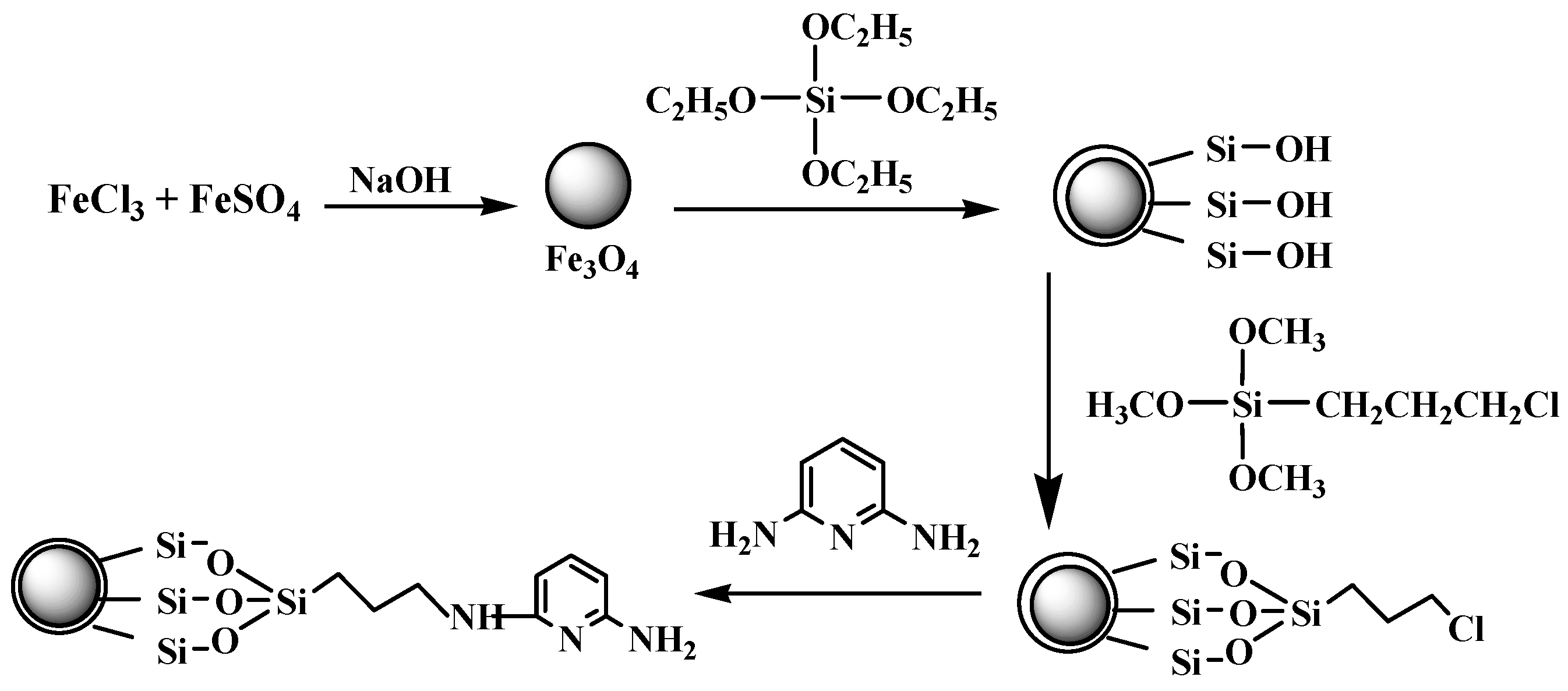
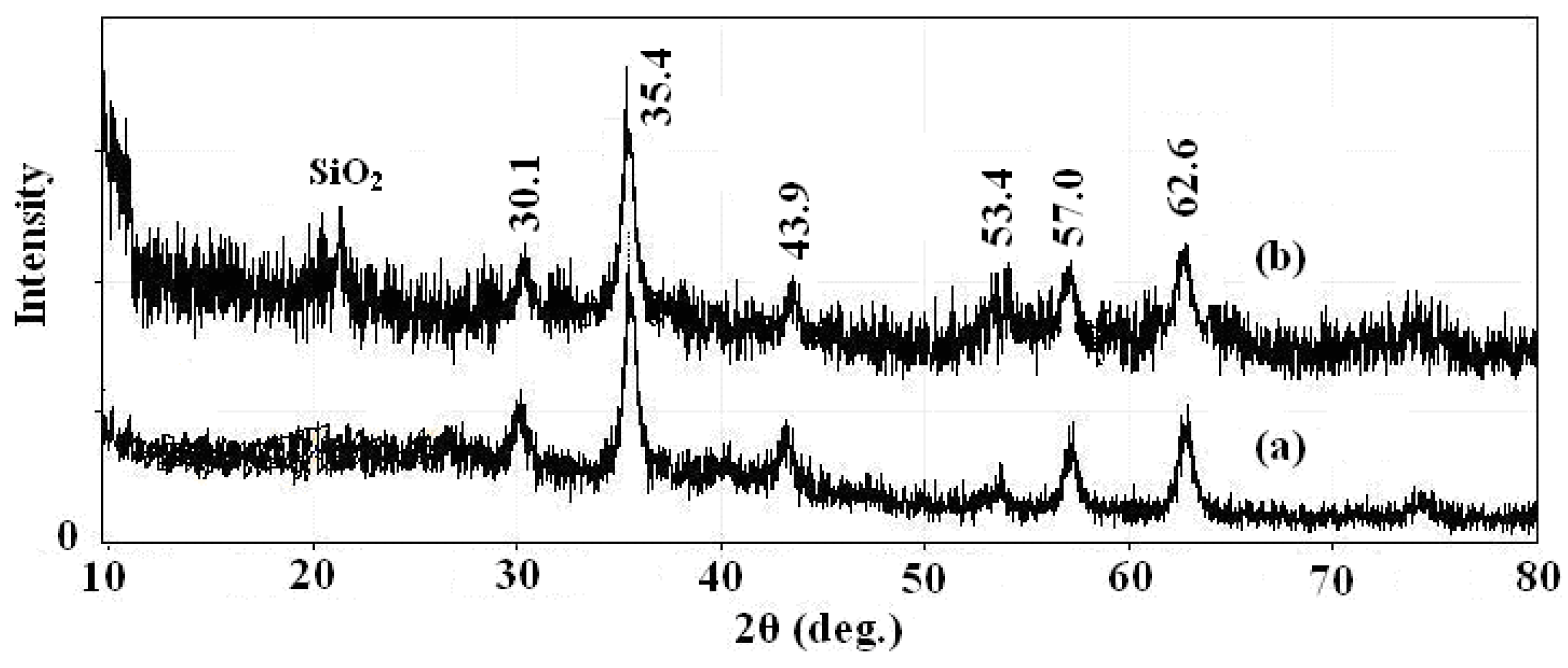
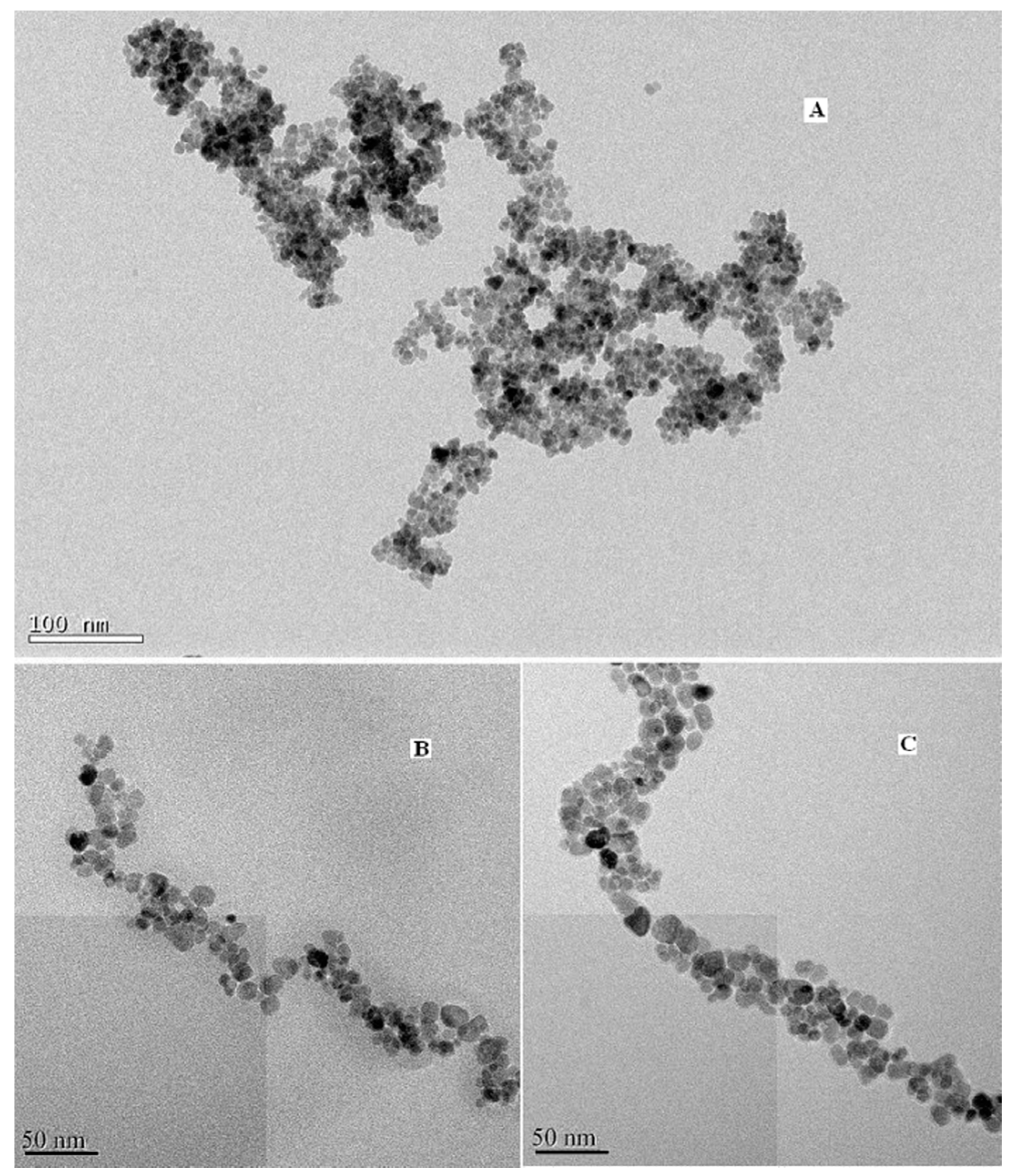
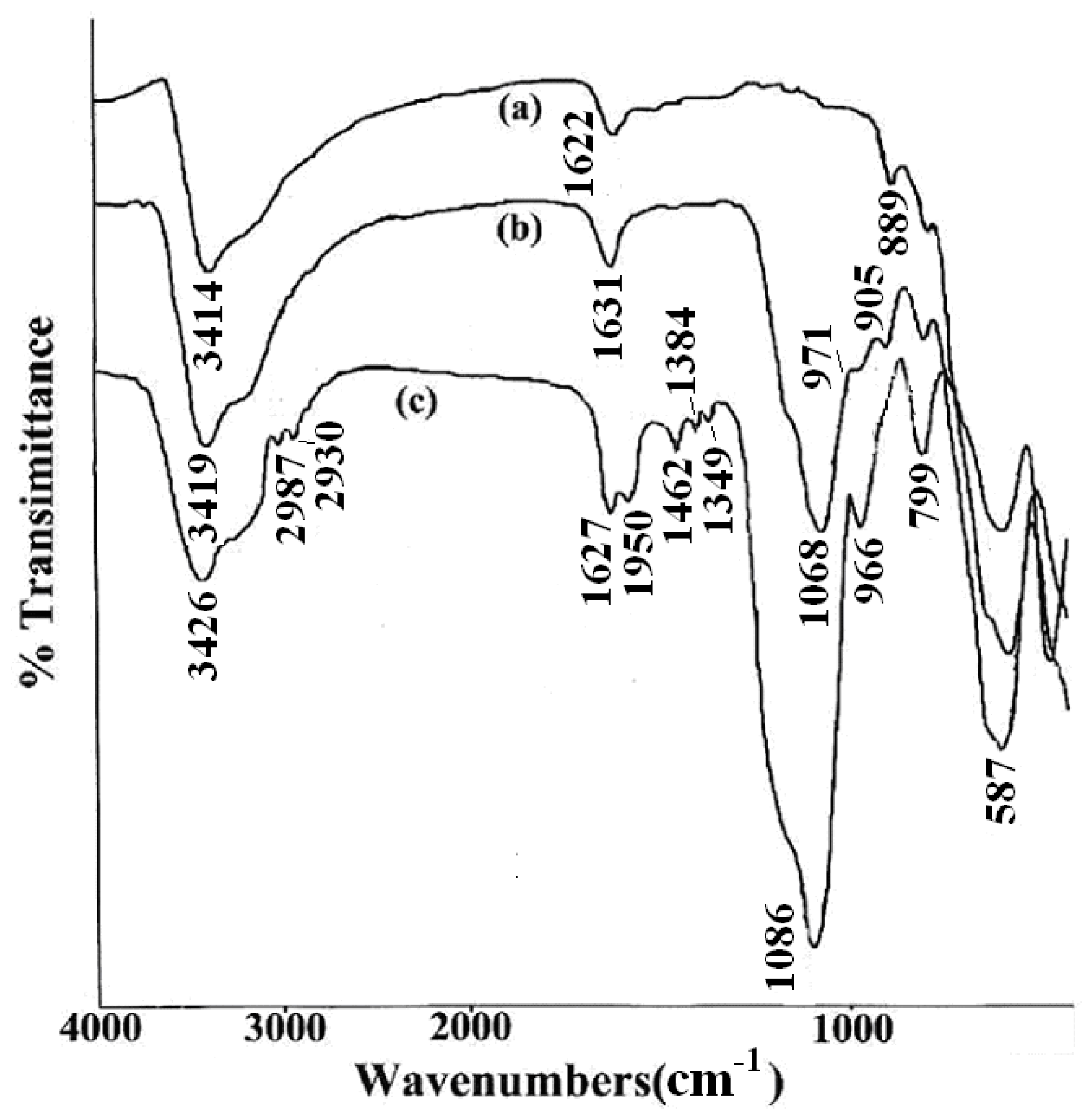
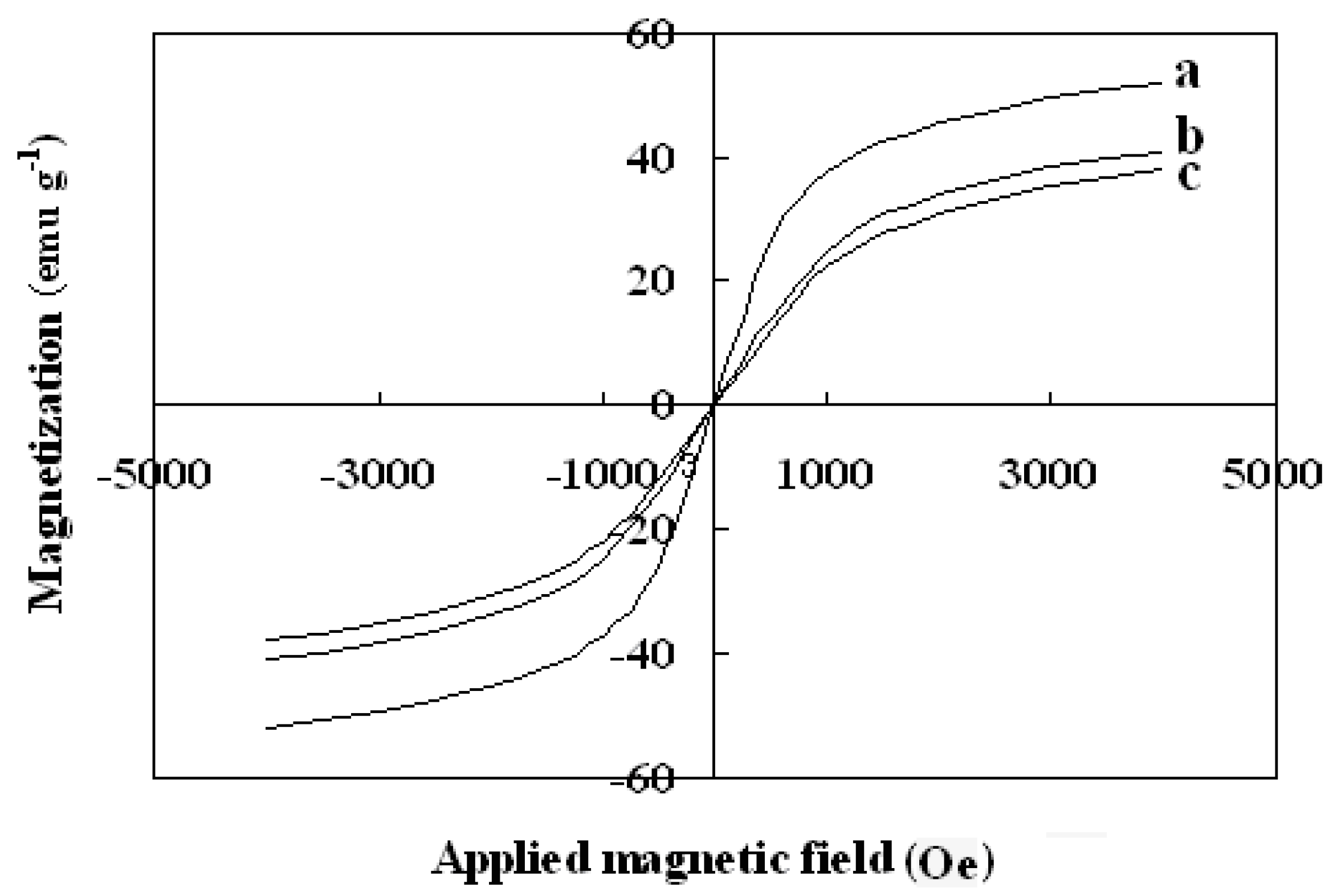
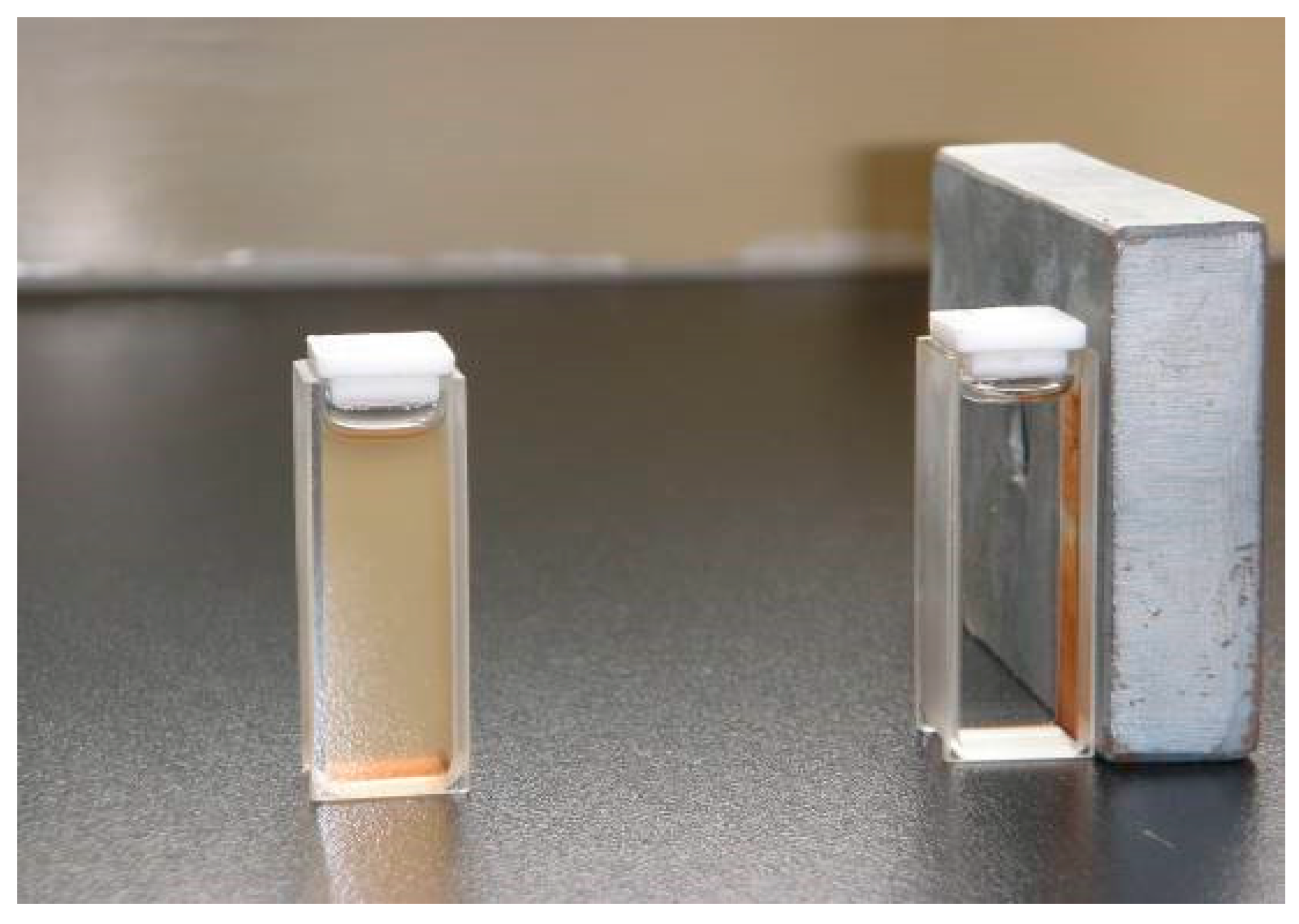
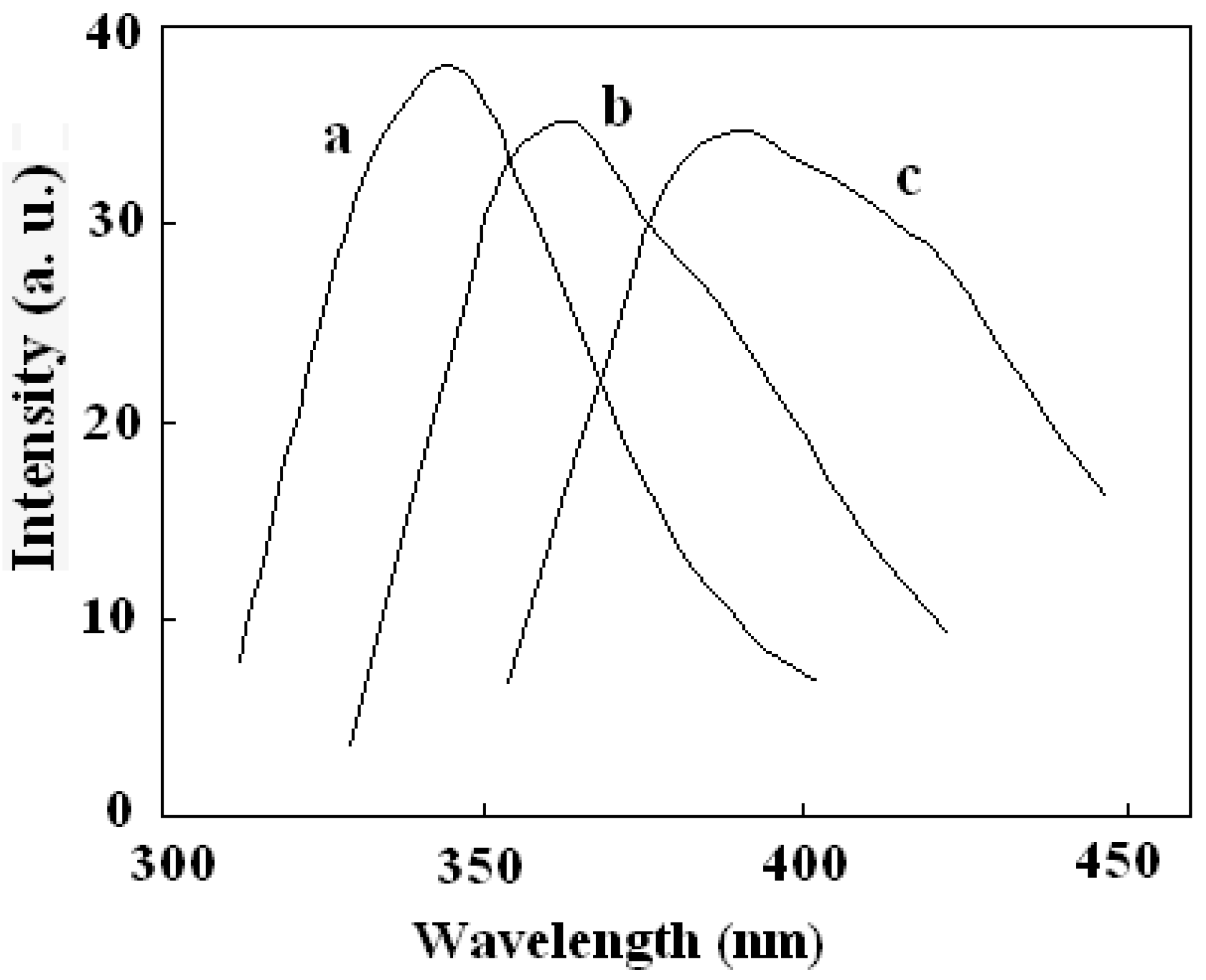
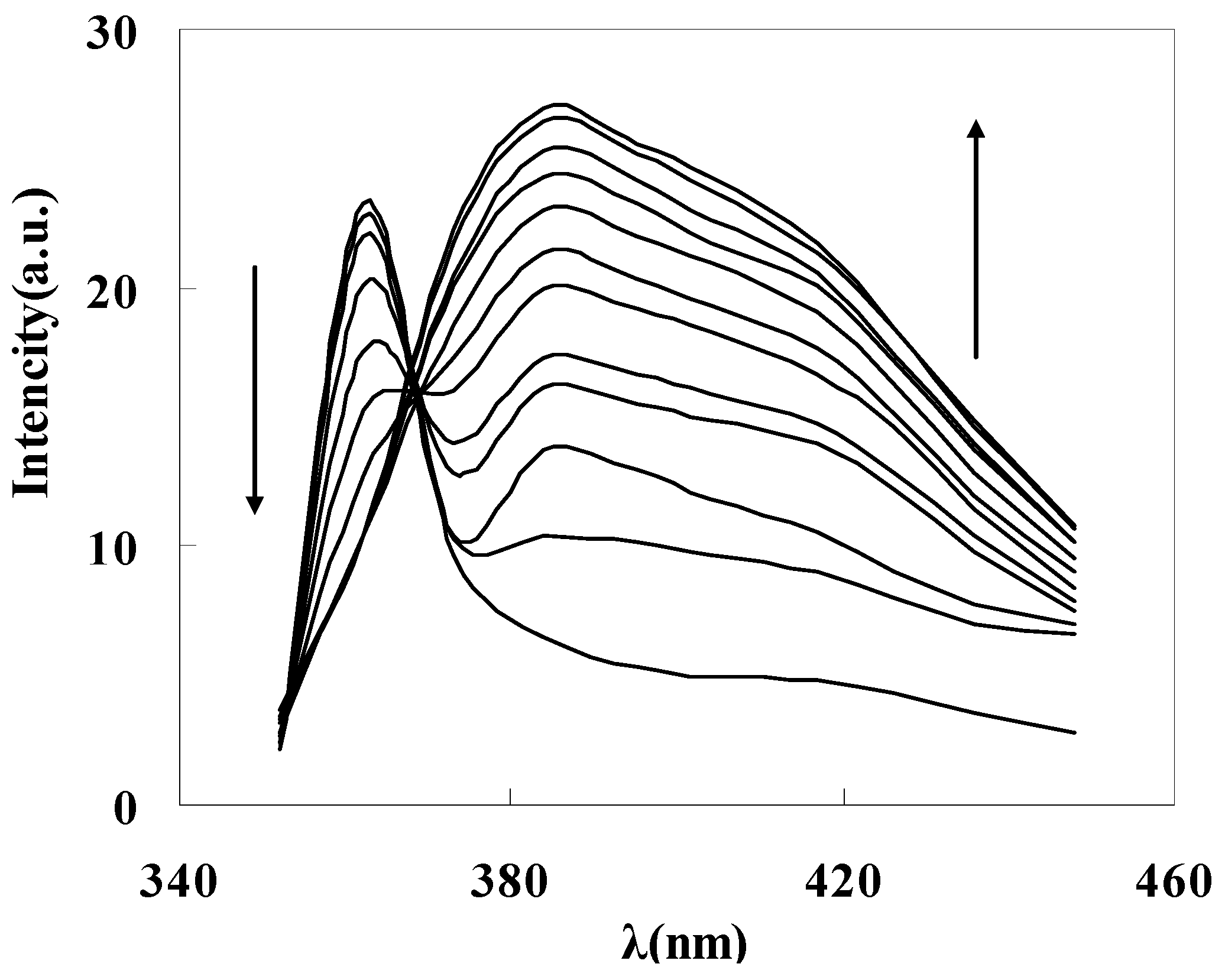
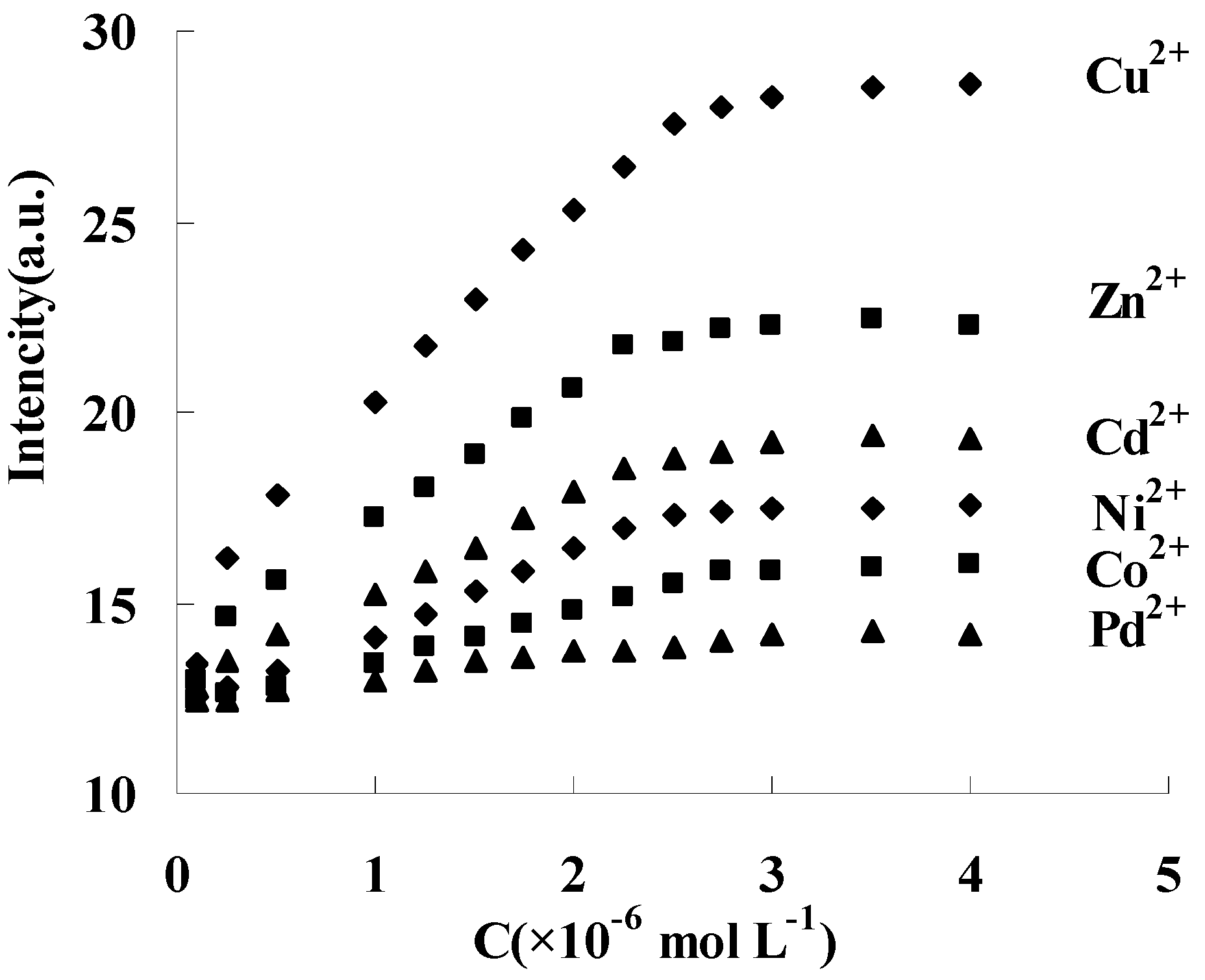
© 2016 by the authors. Licensee MDPI, Basel, Switzerland. This article is an open access article distributed under the terms and conditions of the Creative Commons Attribution (CC-BY) license ( http://creativecommons.org/licenses/by/4.0/).
Share and Cite
Zhai, Y.; Song, R.; Zhang, C.; He, Q.; Han, Q.; Qu, Y. Magnetic, Fluorescence and Transition Metal Ion Response Properties of 2,6-Diaminopyridine Modified Silica-Coated Fe3O4 Nanoparticles. Molecules 2016, 21, 1066. https://doi.org/10.3390/molecules21081066
Zhai Y, Song R, Zhang C, He Q, Han Q, Qu Y. Magnetic, Fluorescence and Transition Metal Ion Response Properties of 2,6-Diaminopyridine Modified Silica-Coated Fe3O4 Nanoparticles. Molecules. 2016; 21(8):1066. https://doi.org/10.3390/molecules21081066
Chicago/Turabian StyleZhai, Yunhui, Ruijuan Song, Changhu Zhang, Qun He, Quan Han, and Yingjuan Qu. 2016. "Magnetic, Fluorescence and Transition Metal Ion Response Properties of 2,6-Diaminopyridine Modified Silica-Coated Fe3O4 Nanoparticles" Molecules 21, no. 8: 1066. https://doi.org/10.3390/molecules21081066
APA StyleZhai, Y., Song, R., Zhang, C., He, Q., Han, Q., & Qu, Y. (2016). Magnetic, Fluorescence and Transition Metal Ion Response Properties of 2,6-Diaminopyridine Modified Silica-Coated Fe3O4 Nanoparticles. Molecules, 21(8), 1066. https://doi.org/10.3390/molecules21081066




